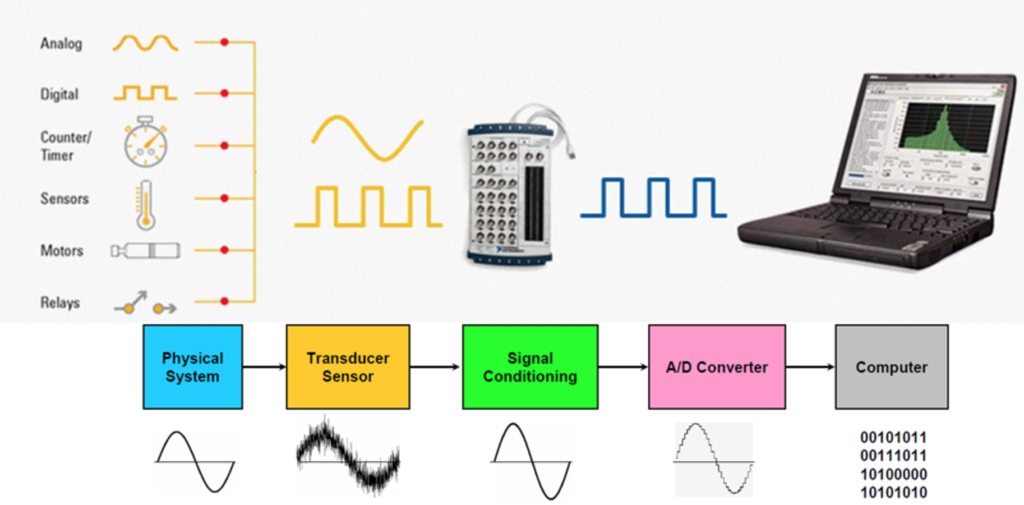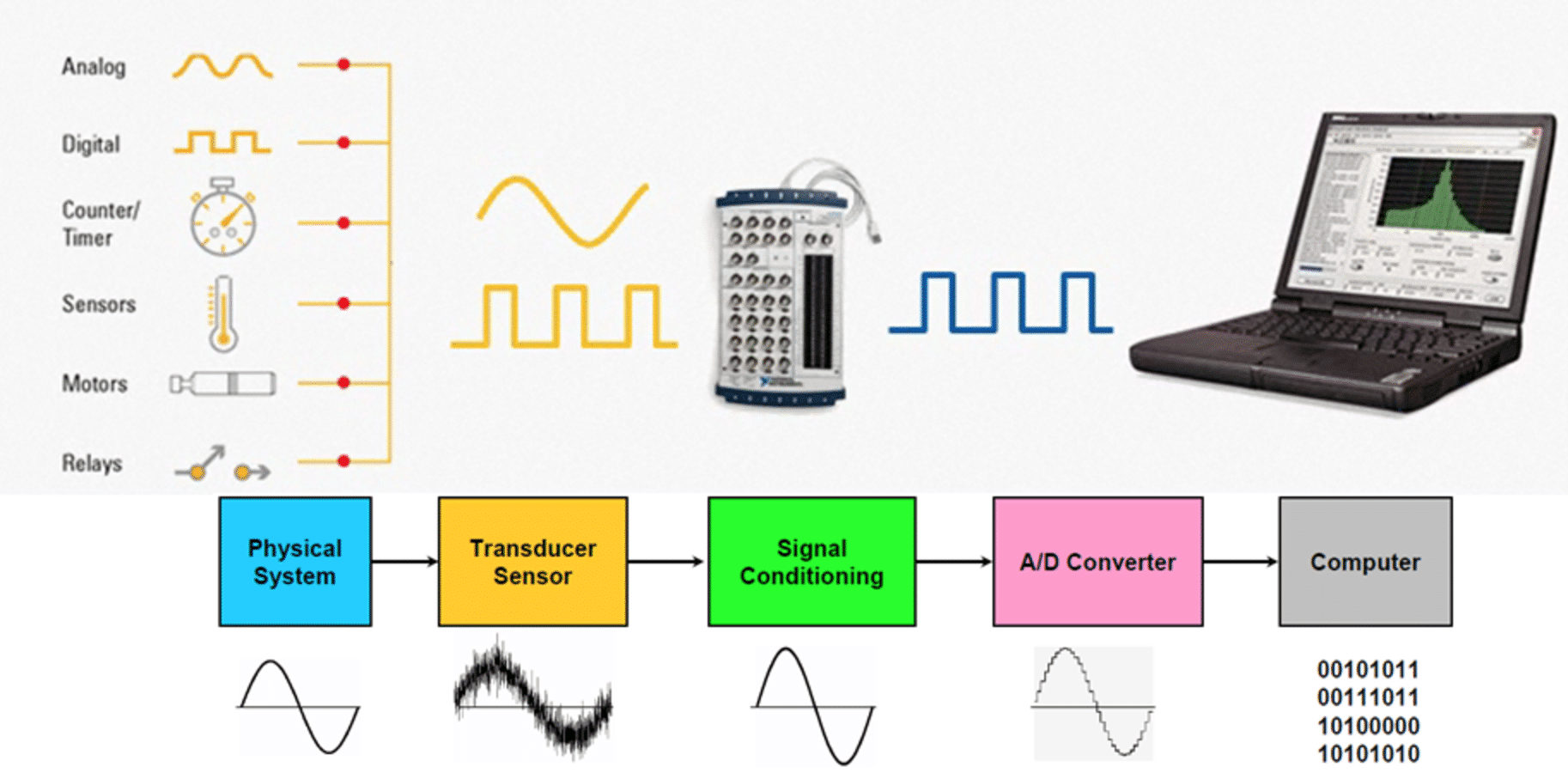
Data Acquisition Systems, often abbreviated to DAS or DAQ, are systems designed to measure and track some form of physical system, and convert this data into a form that can be viewed and manipulated on a computer.
The design an implementation of DAS is a complicated field. The first DAS were designed by IBM back in the 1960s, and were huge assemblages of computers and hardware. As the field has developed, more generic systems have become available, and accordingly it is now possible to measure and analyze almost any form of physical system.
DAS are now used in many different fields, from industrial production to scientific experiments, and the type of system used is different depending on each application.
In general, however, types of DAS can be broken into three components – the sensors used to collect data from the physical systems, the circuitry used to pass this data to a computer, and the computer system on which it can be viewed and analyzed.
If you are setting up a DAS, these are also the three factors that should be considered. Time spent thinking about exactly which data you need to collect, and how you want to work with the data once it is collected, can save significant time and money further down the line.
Let’s take a look some of the most common options in all three of these fields.
Sensors
The design of any DAS must start with the physical system which is being measured. With the range of sensors available today, it is possible to measure almost any physical property of the system you are interested in. Careful consideration must be made, therefore, of exactly the type of data you need to collect. It might be nice to be able to track the temperature of your industrial printer, for instance, but you need to think about whether this information will actually be useful for you.
Examples of common phenomenon that are measured by DAS are temperature, light intensity, gas pressure, fluid flow, and force.
For each variable to be measured, there exists a particular type of sensor. Sensors, in this sense, are essentially transducers, transforming physical energy into electrical energy. For instance, a basic pressure sensor will be activated and driven by the pressure it is measuring, and pass this information as an electronic signal to the DAS.
For this reason, it is important to recognize that it is not possible to measure every variable you want to without effecting the system itself. This is because any sensor will effect the system it is designed to measure, and remove energy from it. This is especially important if the system being measured works on small tolerances, because the addition of even a small sensor to these systems can drain too much energy from them for effective operation.
In short, though there is likely a sensor available to measure almost any aspect of your systems, it is not always wise to try and measure every variable. Instead, think carefully about the data you actually need, and use the minimum number of sensors that will achieve this.
Signal Processing
Typically, DAS use dedicated hardware to pass signals from sensors to the computer systems that will collect and analyze the data. Converting a messy, sometimes noisy, signal from a physical system into a format that can be used and manipulated on a computer can be a tricky business.
One of the first obstacles to be overcome in this regard is signal strength. As outlined above, typically sensors are designed to take the smallest amount of energy possible from the system they are being used to measure. In practice, this also means that the signal they output is of a vey low intensity, and must to amplified to be of any use.
It is therefore critical to use an amplifier that is able to amplify the signal cleanly. A noisy amplifier will ultimately warp and color the data collected, which in some cases can render it useless.
Another thing to think about when designing a DAS is the type of signal that you will use to pass data between the various parts of your system. Most sensors will output a single ended analog signal. Whilst this type of signal is good at capturing the raw state of the system being measured, it is also very susceptible to noise and distortion. A common fix for this problem is to convert the signal coming from the sensors into a differential signal, which is much more stable and easier to work with.
Computer Hardware and Software
Once the signal has been amplified and cleaned up, it must be fed into a computerized system for collection and analysis. Nowadays, most DAS use standard PC hardware, meaning that if components of the system fail, they can be easily replaced with off-the-shelf items.
First and foremost, the signal must be converted into a digital format that the computer understands. Typically, this is done using the pre-existing ports on a PC, such as the parallel ports, USB, etc. Another approach is to use cards connected to slots in the motherboard. With this second approach, a common problem is that the number of ports on a PCI card is too few to accept all of the inputs needed. To work around this problem, a breakout box is used to combine multiple signals into a single input.
DAS cards often contain multiple components that are able to perform signal processing before passing the signal to the software. In the most advanced cards, these functions are accessible via a bus by a microcontroller, though some cheaper systems used hard wired logic. For both types of card, proprietary device drivers are often needed.
The next stage in processing the signal is to pass it to software. Nowadays, a vast variety of different software solutions are available for use with DAQ, and the choice of which to use depends on the type of data being collected and how it needs to be processed. Typically, however, such systems are based on commonly understood programming languages such as C++ or MATLAB, providing a large scope for customization.
Despite these changes, the data acquisition market has changed and DAQ Cards find themselves increasingly an obsolete form of DAQ. Newer devices that allow for more robust feature and capabilities while not being limited by fixed cards are now starting to dominate the market.
The Advantages of DAQifi Devices
DAQ cards typically output data using a dedicated hard link, and in years past this often meant having a separate PC workstation for every data acquisition process. Not only did this mean extra expense in terms of hardware, it often meant that bringing data from several processes together was a manual, painful business. DAQifi cards send the collected data over a WiFi network – either an existing one, or one generated by the device itself – to custom software.
What this means in practice is that a single PC, tablet, or even smart phone can be used to aggregate all the data being collected, bringing it all together for easy analysis and manipulation. This also means that the computer being used to collect and manipulate data does not need any additional hardware to be used for this purpose.
In addition, DAQifi devices represent better value than many DAQ card solutions. This is because DAQ cards are often made to be used to collect one type of data only, and in many cases this means that a bank of cards must be used in order to collect even quite basic data. The flexibility of DAQifi devices makes them cheaper to implement in many situations.
This is especially true in situations where portability is paramount. The fact that DAQifi devices run on their own power makes them ideal for situations where having a dedicated PC workstation is simply impossible. This is the case in many industrial processes, where the environment is not conducive to the health of computer hardware, and also in situations where the system under study is inherently mobile, such as in automotive engineering.
Lastly, the user interface which comes as standard on DAQifi devices means that using them is incredibly simple in comparison to many DAQ card solutions. Often, even in high-end scientific applications, all that is needed from a data acquisition system is for it to feed data to a centralized device, in a format which is easy to work with, for later analysis.
This is exactly what DAQifi devices achieve, and it is therefore not surprising that they are eclipsing DAQ card solutions in many situations.
Read more about this in our DAQ vs DAQifi post.

